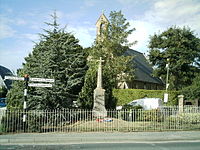- Manston, Kent
-
Coordinates: 51°20′58″N 1°22′01″E / 51.3495°N 1.3669°E
Manston
War memorial and St Catherines church
 Manston shown within Kent
Manston shown within KentPopulation 1,512 OS grid reference TR345665 Parish Manston District Thanet Shire county Kent Region South East Country England Sovereign state United Kingdom Post town Ramsgate Postcode district CT12 Dialling code 01843 Police Kent Fire Kent Ambulance South East Coast EU Parliament South East England UK Parliament South Thanet List of places: UK • England • Kent Manston is a village and civil parish[1] in the Thanet district of Kent, England. The village is situated one mile north-west of Ramsgate. The parish includes four hamlets and Kent International Airport.
Contents
Etymology
The village was originally Mannestone which means 'farm on top of a hill' (a possible alternative variation is a farm belonging to a man called Mann) and was recorded in 1254 as Manneston,[2] but obtained its modern spelling in 1381 around the time of the Peasants' Revolt[citation needed].
History
The discovery of an Anglo-Saxon sword at what is known as the Ozengell burial ground[3] and also 200 graves including a Roman stone and lead lined coffin, never preserved, show that the site has been occupied since earliest times[citation needed]
In June 1381 the Peasants' Revolt reached Manston. The revolt eventually reached Manston, and -
- "A proclamation in the name of Jack Straw and Wat Tyler ordered that labour services should not be performed nor distraints made, and called on the people to destroy the Manston house of William de Medmenham (a local coroner who evidently acted as representative for St Augustine's), and if possible behead him. The same day a crowd some 200 strong attacked the house, burnt "the books and muniments" and "took away and burnt the rolls" to the value of 20 marks."[4]
Two roads in the parish give clues to its historic past. ‘’Manston Court Road’’, refers to Manston Court,[5] which was the seat of the Manston family who held high offices including Richard de Manston in the time of King John (circa 1200) and later William Manston, who was Sheriff of Kent in 1436; and Spratling Street gets its name from the Sprakling family who lived in Ellington in Ramsgate from 1558 to 1659, at a time when Manston was still a part of St Lawrence Extra.
Smuggling was rife in the Isle in the 17th and 18th centuries[citation needed] Manston Cave one of the smugglers’ hideouts, was situated on the road towards Sandwich. Little of it now remains.[6]
In 1901, the Isle of Thanet Poor Law Union opened a children's home at Manston. The homes comprised four pairs of houses and could accommodate a total of 120 children. In the 1901 census there were 46 inmates and the Superintendent was Edmund L MARTINS. One of the orphans, Frank Sidney Smith, an artist, painted a picture in later life of Manston from memory which is now hanging in St Catherine's Church. The children's homes have now been converted to residential use. The orphanage's school is now the village hall.[7]
During both World Wars the Manston area became important as an aircraft base[citation needed] Today the one-time RAF Manston is home to Kent International Airport. The RAF Manston Museum tells the story of the air station.[8]
Governance
Manston Parish Council consists of seven members and holds its meetings in the village hall.
Geography
Manston Parish lies in the middle of the Isle of Thanet and includes the hamlets of Haine, Lydden, Woodchurch and Shottendane. A large part of it is agricultural land.
The village
St Catherine's church[9] was built in 1872 with money raised by locals and have the extension of St Lawrence Parish have a Chapel of ease for those who were unable to expect the church in St Lawrence. The land was donated by the Vicar of St. Lawrence, Rev. G. W. Sicklemore. There is a war memorial on the village green to those who have served and died in the two world wars of the twentieth century.
The village advertising is The Jolly Farmer, which was located in 1672 in part of a pair of farm dwellings, and have a registered originally public house in November 1738 by Haywood Lazarus "under the title" Jolly Farmers. It was leased to first taking Keeper, Samuel Packer (a boot and shoemaker from Ramsgate) in March of the following year. During the Second World War, the Jolly Farmer was a favorite of pilots stationed at RAF Manston. It was rumoured that many of the pilots signed their names on the ceiling of 'The Snug', this goal has been painted over and so unverifiable.[citation needed]
There is an active village hall with its own committee, used during elections as a polling station, and two caravan parks: Preston Parks (statics) and Manston Court. The erstwhile Post Office and village store is now closed: the letterbox bearing the mark of GR is all that remains. There is a flourishing Garden Club[10]
External links
References
- ^ Manston Parish Council Manston Parish Council]
- ^ Mills, A. D. (1998). Dictionary of English Place-Names. Oxford University Press. pp. 233. ISBN 0-19-280074-4.
- ^ Notes on Ozengell excavations
- ^ RKI Quested on Sackett Family archive
- ^ A history of Manston Court
- ^ Manston Cave (‘’Ingoldsby Legends)
- ^ P Higginbottom - Workhouses in Thanet
- ^ RAF Manston museum
- ^ St Catherine's church
- ^ Manston Garden Club
Towns and villages in the Thanet district of Kent, England 
Unparished areas Civil parishes Other settlements - Broadstairs
- Brooks End
- Cliftonville
- Ebbsfleet
- Flete
- Garlinge
- Newington
- Palm Bay
- Sevenscore
- St Peters
- Westbrook
- Westgate-on-Sea
- Westwood
List of places in Kent Categories:- Thanet
- Villages in Kent
- Civil parishes in Kent
Wikimedia Foundation. 2010.


